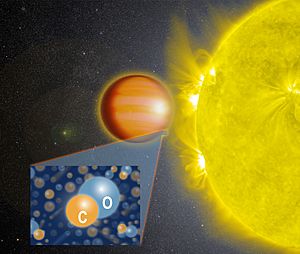WASP-18b facts for kids

How WASP-18b compares in size to Jupiter.
|
|
| Discovery | |
|---|---|
| Discovered by | Hellier et al. (SuperWASP) |
| Discovery date | August 27, 2009 |
|
Detection method
|
Transit (including secondary eclipses) |
| Orbital characteristics | |
| Apastron | 0.02045 AU (3,059,000 km) |
| Periastron | 0.02007 AU (3,002,000 km) |
| 0.02026 ± 0.00068 AU (3,031,000 ± 102,000 km) | |
| Eccentricity | 0.0092 ± 0.0028 |
| 0.94145455+0.00000087 −0.00000132 d 22.59487 h |
|
| Inclination | 86 ± 2.5 |
| 96 ± 10 | |
| Star | WASP-18 |
| Physical characteristics | |
|
Mean radius
|
1.106+0.072−0.054 RJ |
| Mass | 10.3 ± 0.69 MJ |
| Temperature | 2500+200−{{{2}}} |
WASP-18b is a special extrasolar planet, also called an exoplanet. It is known for orbiting its star very quickly. One year on WASP-18b lasts less than one Earth day.
This planet is huge, about 10 times the mass of Jupiter. This makes it almost as big as a brown dwarf. Brown dwarfs are objects that are bigger than planets but smaller than stars.
WASP-18b is slowly being pulled closer to its star, WASP-18. Scientists think it will crash into its star in less than a million years. This is due to something called tidal forces.
The planet is about 3.1 million km (1.9 million mi; 0.021 AU) away from its star. Its star is about 410 light-years (130 parsecs) from Earth. A team led by Coel Hellier, a professor from Keele University in England, found this exoplanet.
Contents
Why is WASP-18b so interesting?
Scientists are trying to understand why WASP-18b is so close to crashing into its star. It seems to be very near the end of its life. They want to know if this is just a lucky find, or if something else is happening.
They are studying if the star WASP-18 is not pulling on the planet as strongly as expected. Over the next 10 years, they hope to measure how fast WASP-18b's orbit is shrinking.
How does WASP-18b compare to our Solar System?
The closest example to WASP-18b in our Solar System is Mars' moon, Phobos. Phobos orbits Mars very closely. It is only about 9,000 km (5,600 mi) away from Mars. This is 40 times closer than our Moon is to Earth.
Scientists believe Phobos will also be destroyed. It is expected to break apart in about 11 million years.
What is the temperature on WASP-18b?
In 2020, scientists measured the temperature on the day side of WASP-18b. It was extremely hot, around 3,029 ± 50 K (2,755.8 ± 50.0 °C; 4,992.5 ± 90.0 °F).
How does WASP-18b orbit its star?
A study in 2012 looked at how WASP-18b orbits its star. They found that the planet's path is mostly lined up with the star's equator. The tilt, or misalignment, is only about 13 degrees.

See also
 In Spanish: WASP-18b para niños
In Spanish: WASP-18b para niños
- SuperWASP

